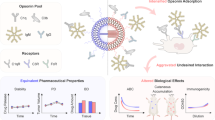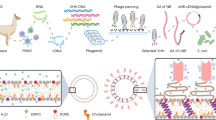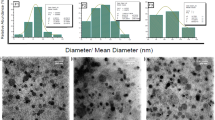Abstract
A sterically stabilized immunolipoplex (TsPLP), containing an antitransferrin receptor single-chain antibody fragment (TfRscFv)-PEG molecule, has been developed to specifically and efficiently deliver a therapeutic gene to tumor cells. A postcoating preparation strategy was employed in which a DNA/lipid complex (lipoplex) was formed first and then sequentially conjugated with PEG and TfRscFv. The complex prepared by this method was shown to be superior in ability to deliver genes to tumor cells than when prepared by a common precoating strategy, in which DNA is mixed with TfRscFv-PEG conjugated liposome. Using prostate cancer cell line DU145, a comparison was made between the in vitro and in vivo gene delivery efficiencies of four complexes, Lipoplex (LP), PEG-Lipoplex (PLP), TfRscFv-PEG-Lipoplex (TsPLP) and our standard TfRscFv-Lipoplex (TsLP). In vitro, the order of transfection efficiency was TsLP>LP≈TsPLP>PLP. However, in vivo the order of transfection efficiency, after systemic administration via the tail vein, was TsPLP>TsLP>LP or PLP with TsPLP-mediated exogenous gene expression in tumor being two-fold higher than when mediated by TsLP. This suggests that the in vitro transfection efficiency of TsPLP was not indicative of its in vivo efficiency. In addition, it was found that the level of exogenous gene expression in the tumor mediated by TsPLP was higher than that mediated by TsLP and did not decrease over the time. More importantly, high exogenous gene expression in tumor, but low expression in liver, was observed after an i.v. delivery of TsPLP carrying either the GFP reporter gene or the p53 gene, indicating that tumor preferential targeting was maintained by this complex in the presence of PEG. These findings show that incorporation of PEG into our targeted lipoplex results in a more efficient delivery of the complex to the tumor cells, possibly by inhibiting the first pass clearance observed with non-PEG containing liposomes. Therefore, these data demonstrate that TsPLP is a improvement over our previously established tumor targeted gene delivery complex for systemic gene therapy of cancer.
This is a preview of subscription content, access via your institution
Access options
Subscribe to this journal
Receive 12 print issues and online access
$259.00 per year
only $21.58 per issue
Buy this article
- Purchase on Springer Link
- Instant access to full article PDF
Prices may be subject to local taxes which are calculated during checkout





Similar content being viewed by others
References
Fenske DB, MacLachlan I, Cullis PR . Stabilized plasmid–lipid particles: a systemic gene therapy vector. Methods Enzymol 2002; 346: 36–71.
Woodle MC, Lasic DD . Sterically stabilized liposomes. Biochim Biophys Acta 1992; 1113: 171–199.
Blessing T et al. Different strategies for formation of pegylated EGF-conjugated PEI/DNA complexes for targeted gene delivery. Bioconjugate Chem 2001; 12: 529–537.
Guo W, Lee RL . Receptor-targeted gene delivery via folate-conjugated polyethylenimine. AAPS Pharm Sci 1999; 1: E19.
Chluba J, Lima DS, Frisch B, Schuber F . Enhancement of gene delivery by an analogue of alpha-MSH in a receptor-independent fashion. Biochim Biophys Acta 2001; 1510: 198–208.
Pun SH, Davis ME . Development of a nonviral gene delivery vehicle for systemic application. Bioconjugate Chem 2002; 13: 630–639.
Hofland HE et al. Folate-targeted gene transfer in vivo. Mol Ther 2002; 5: 739–744.
Kircheis R et al. Tumor-targeted gene delivery: an attractive strategy to use highly active effector molecules in cancer treatment. Gene Ther 2002; 9: 731–735.
Kursa M et al. Novel shielded transferrin-polyethylene glycol-polyethylenimine/DNA complexes for systemic tumor-targeted gene transfer. Bioconjugate Chem 2003; 14: 222–231.
Ogris M et al. PEGylated DNA/transferrin-PEI complexes: reduced interaction with blood components, extended circulation in blood and potential for systemic gene delivery. Gene Ther 1999; 6: 595–605.
Kichler A et al. Intranasal gene delivery with a polyethylenimine-PEG conjugate. J Control Release 2002; 81: 379–388.
Gabizon A et al. Targeting folate receptor with folate linked to extremities of poly(ethylene glycol)-grafted liposomes: in vitro studies. Bioconjugate Chem 1999; 10: 289–298.
Song LY et al. Characterization of the inhibitory effect of PEG-lipid conjugates on the intracellular delivery of plasmid and antisense DNA mediated by cationic lipid liposomes. Biochim Biophys Acta 2002; 1558: 1–13.
Shi F et al. Interference of poly(ethylene glycol)-lipid analogues with cationic-lipid-mediated delivery of oligonucleotides; role of lipid exchangeability and non-lamellar transitions. Biochem J 2002; 366: 333–341.
Audouy S, de Leij L, Hoekstra D, Molema G . In vivo characteristics of cationic liposomes as delivery vectors for gene therapy. Pharm Res 2002; 19: 1599–1605.
Xu L, Pirollo KF, Chang EH . Transferrin-liposome-mediated p53 sensitization of squamous cell carcinoma of the head and neck to radiation in vitro. Hum Gene Ther 1997; 8: 467–475.
Xu L, Pirollo KF, Chang EH, Murray A . Systemic p53 gene therapy in combination with radiation results in human tumor regression. Tumor Targeting 1999; 4: 92–104.
Xu L et al. Transferrin-liposome-mediated systemic p53 gene therapy in combination with radiation results in regression of human head and neck cancer xenografts. Hum Gene Ther 1999; 10: 2941–2952.
Xu L, Pirollo KF, Chang EH . Tumor-targeted p53 gene therapy enhances the efficacy of conventional chemo/radiotherapy. J Control Release 2001; 6: 115–128.
Xu L et al. Systemic p53 gene therapy of cancer with immunolipoplexes targeted by anti-transferrin receptor scFv. Mol Med 2001; 7: 723–734.
Xu L et al. Self-assembly of a virus-mimicking nanostructure system for efficient tumor-targeted gene delivery. Hum Gene Ther 2002; 13: 469–481.
Xu L et al. Systemic tumor-targeted gene delivery by anti-Transferrin receptor scFv-immunoliposomes. Mol Cancer Ther 2002; 1: 337–346.
Maruyama K, Ishida O, Takizawa T, Moribe K . Possibility of active targeting to tumor tissues with liposomes. Adv Drug Del Rev 1999; 40: 89–102.
Barron LG, Meyer KB, Szoka FC . Effects of complement depletion on the pharmacokinetics and gene delivery mediated by cationic lipid-DNA complexes. Hum Gene Ther 1998; 9: 315–323.
Dash PR et al. Factors affecting blood clearance and in vivo distribution of polyelectrolyte complexes for gene delivery. Gene Ther 1999; 6: 643–650.
Nishikawa M, Huang L . Nonviral vectors in the new millennium: delivery barriers in gene transfer. Hum Gene Ther 2001; 12: 861–870.
Chesnoy S, Huang L . Structure and function of lipid–DNA complexes for gene delivery. Annu Rev Biophys Biomol Struct 2000; 29: 27–47.
Yu W et al. Enhanced transfection efficiency of a systemically delivered tumor-targeting immunolipoplex by inclusion of a pH-sensitive histidylated oligolysine peptide. Nucleic Acids Res 2004; 32: e48.
Acknowledgements
We thank Ms Leanne Sleer for extensive assistance in the editorial preparation of this manuscript. We also thank the LCC Animal Research Resource, Macro Molecular Synthesis Shared Resource Facility and Tissue Culture Shared Resource Facility for their assistance in these studies. This work was supported in part by an NIH grant (DE13151) to EHC, a grant from SynerGene Therapeutics, Inc. (SGT) to KFP, an NIH STTR phase I (1R41CA 80449) and phase II (2R42 CA80449) to SGT (EHC and KFP).
Author information
Authors and Affiliations
Rights and permissions
About this article
Cite this article
Yu, W., Pirollo, K., Rait, A. et al. A sterically stabilized immunolipoplex for systemic administration of a therapeutic gene. Gene Ther 11, 1434–1440 (2004). https://doi.org/10.1038/sj.gt.3302304
Received:
Accepted:
Published:
Issue Date:
DOI: https://doi.org/10.1038/sj.gt.3302304
Keywords
This article is cited by
-
A Phase l Study of a Tumor-targeted Systemic Nanodelivery System, SGT-94, in Genitourinary Cancers
Molecular Therapy (2016)
-
Transferrin receptor targeting nanomedicine delivering wild-type p53 gene sensitizes pancreatic cancer to gemcitabine therapy
Cancer Gene Therapy (2013)
-
Phase I Study of a Systemically Delivered p53 Nanoparticle in Advanced Solid Tumors
Molecular Therapy (2013)
-
Imaging of cationic multifunctional liposome-mediated delivery of COX-2 siRNA
Cancer Gene Therapy (2009)
-
Transferrin-Associated Lipoplexes as Gene Delivery Systems: Relevance of Mode of Preparation and Biophysical Properties
Journal of Membrane Biology (2008)



